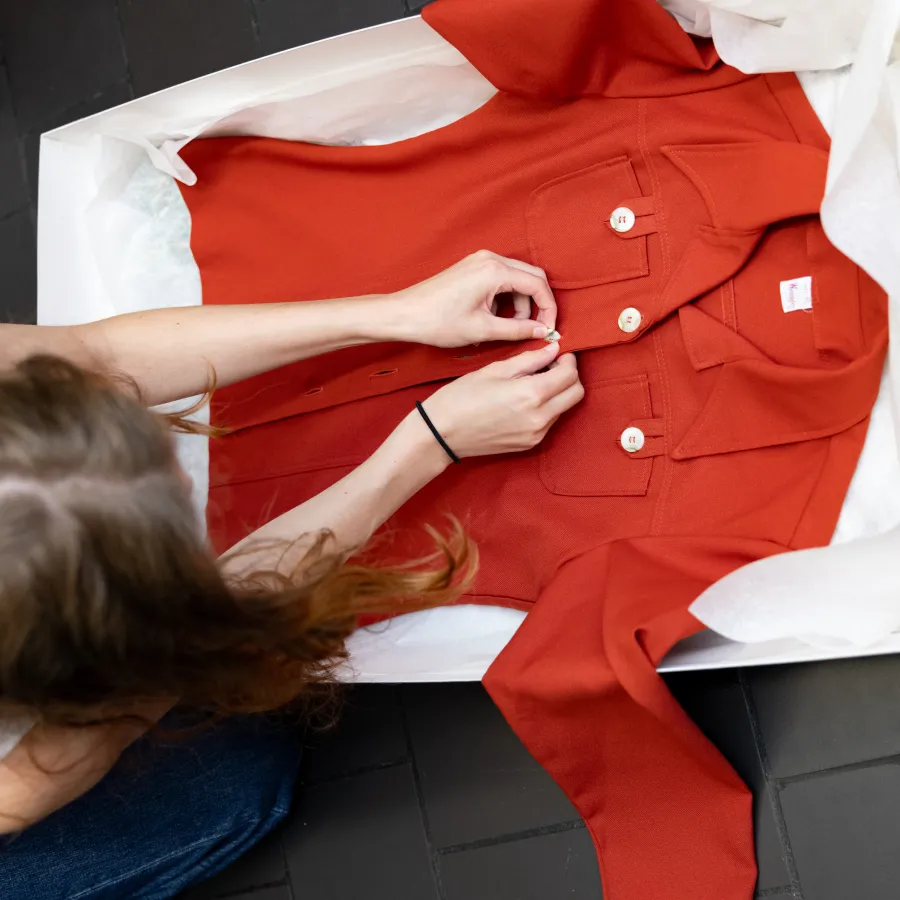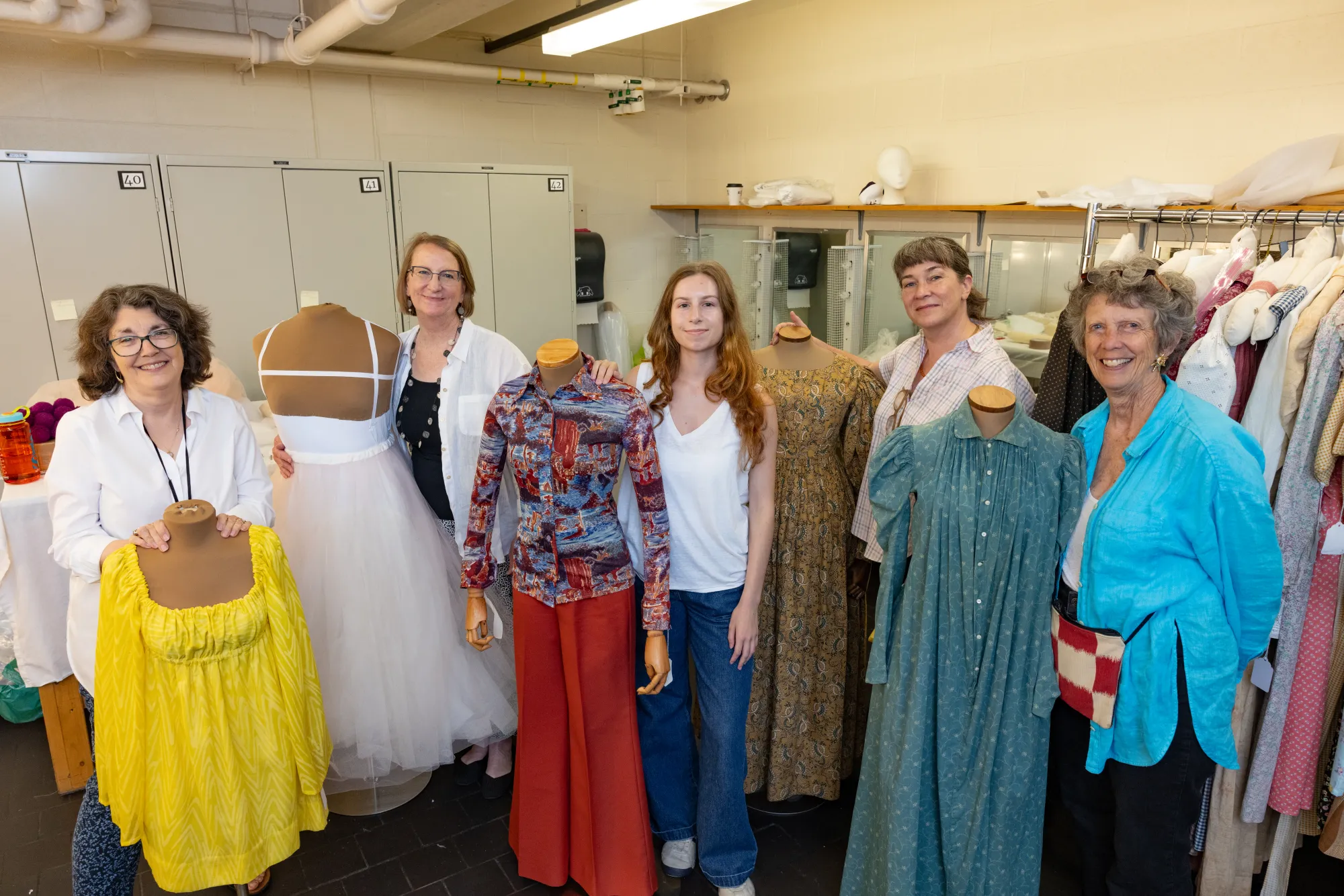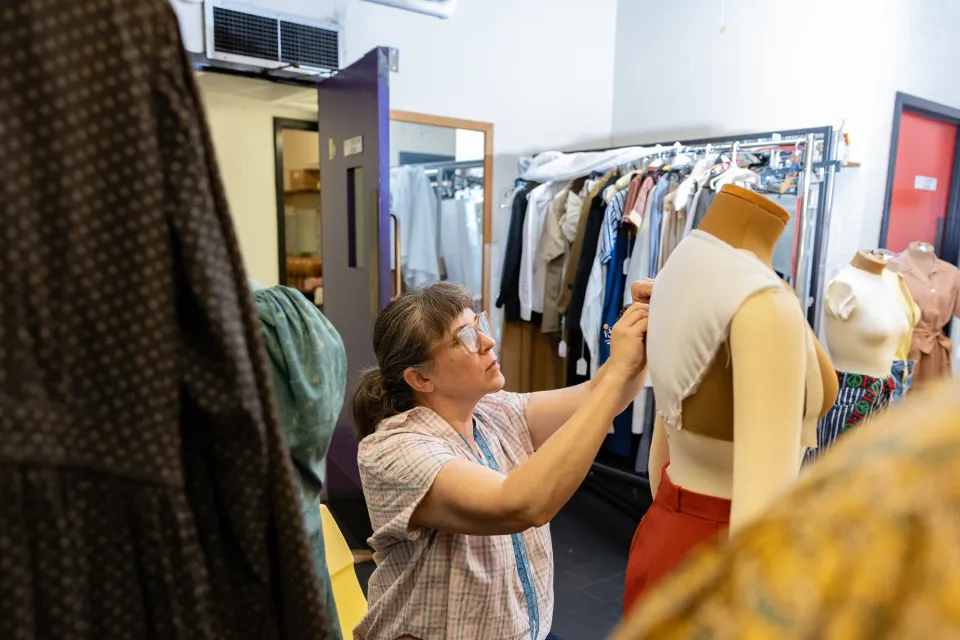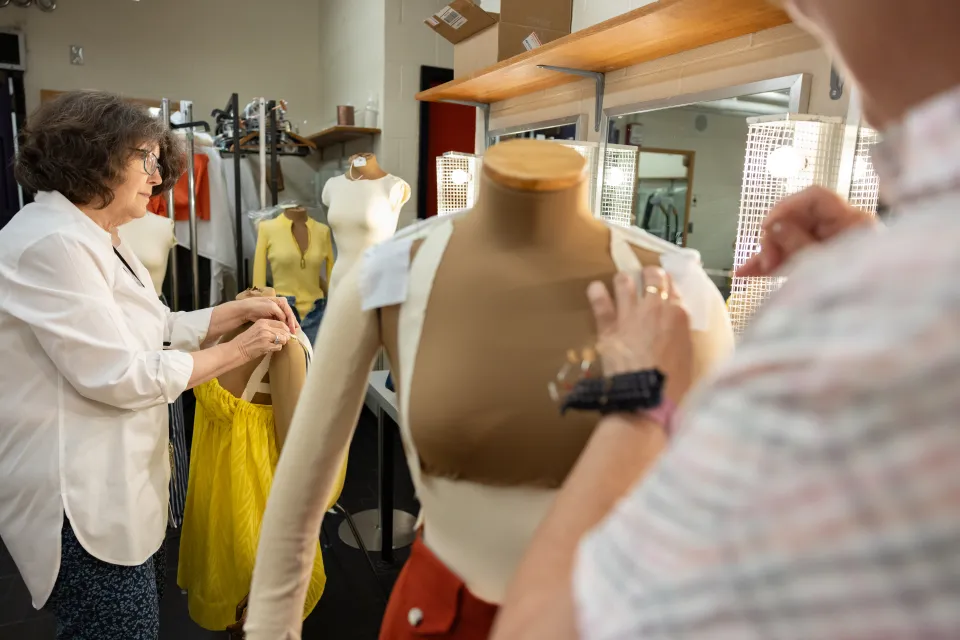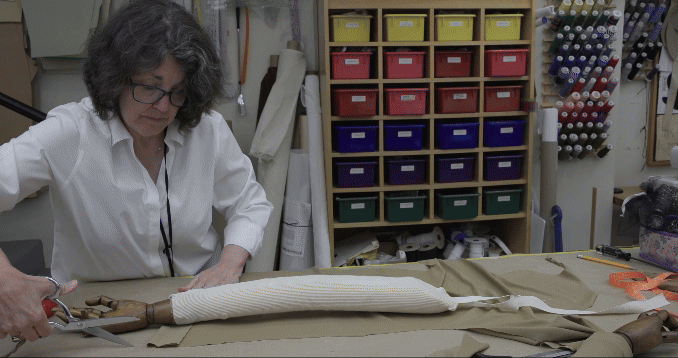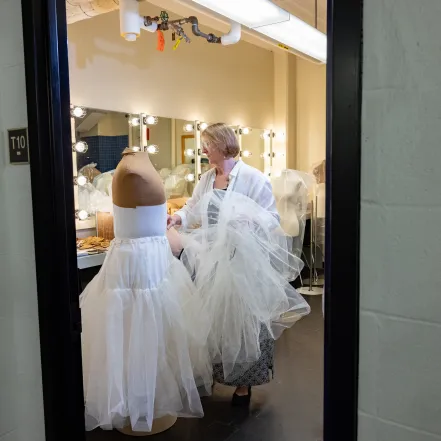The Smith College Historic Clothing Collection Goes on the Road
Research & Inquiry
Part two of “Women’s Clothes and the Stories They Tell” looks at the laborious undertaking of preparing the collection for its museum debut.
Smith College Clothing Collection intern Virginia Cornett ’27 packs up a 1970s polyester pantsuit jacket by Wrangler, which will be on display at the New-York Historical Society exhibition this fall.
Published July 23, 2024
Part Two: The Process
With the publication of Real Clothes, Real Lives by Kiki Smith ’71, and an exhibit at the New-York Historical Society set for later this year, the Smith College Historic Clothing Collection is finally getting the recognition it deserves. This series will chronicle what makes the collection unique, its pedagogical possibilities, its impact on Smith students and alums, and the laborious process of sharing the collection with the world.
The process of curating the Smith College Historic Clothing Collection’s (SCHCC) first major exhibit is in the hands of some very capable experts, all of whom have at least one thing in common: They’ve known, worked with, and admired Professor of Theatre Kiki Smith ’71 for years. “It didn’t take but a moment for me to say yes to Kiki when she asked for help putting together this exhibit,” says Rebecca Shea ’99, who heads New York–based RCS Fine Art, a costume exhibition display and collection management firm. “The collection fosters a great community that has supported me over the years, so of course I’m happy to assist in preserving the collection and contributing to this project.”
Smith is chief curator of the exhibition and director of the collection, whereas Shea, in her role as curator, serves as a liaison with the New-York Historical Society. “I interface and collaborate with the curators there to bring Kiki’s vision to the exhibition,” says Shea. In addition, Lynne Zacek Bassett (Mount Holyoke ’83) and Lizz Roos ’80 are part of the invaluable team working with Shea and Smith to make the exhibit come to life. Bassett, formerly curator of collections at Historic Northampton and curator of textiles and fine arts at Old Sturbridge Village, is an award-winning freelance curator specializing in historic fashion and textiles. Roos is a fiber artist whose work has been featured in Fiber Art Now magazine and a retired faculty member at Keene State College in Keene, NH, where she taught costume design and served as chair of the department of theater and dance and dean of the school of arts and humanities. Here, the team talks about the importance of the upcoming SCHCC exhibit and the various stages of preparing the collection for its major public debut.
Beauty in the Ordinary
Rebecca Shea: “I want to make people aware of the significance of these documentary garments. These are not the fantasy of couture garments but what women chose to wear to face the obstacles of their everyday lives. At the same time, [the exhibit] will trace how women’s lives and roles have evolved over 200 years. In selecting pieces to illustrate the exhibition concept, you ask questions such as, ‘What is the message you want people to take away from these suits from the 1940s?’ ‘Which pieces can convey that message most directly?’ It’s balancing the concept creation and object selection and having them meet. Exhibition copy is constantly being written, and conservators and other [team members] give their input. You may find another garment that is closer to your concept, and then more refinement comes. It’s a meticulous process that requires constant balancing of the details of the objects and the big picture of the message of the exhibition.”
Posing with some of the garments headed to the New York Historical Society this fall are (left to right) Lizz Roos ’80; Lynne Zacek Bassett (Mount Holyoke ’83); Virginia Cornett ’27, STRIDE scholar and intern; Rebecca Shea ’99; and Kiki Smith ’71, professor of theatre and author of Real Clothes, Real Lives: 200 Years of What Women Wore: The Smith College Historic Clothing Collection.
Measuring, Stitching, and Stuffing
Lizz Roos: “I’m doing the nuts and bolts of helping to make sure everything that needs to move to New York is going to be under control. I’m taking an overview and making a ton of lists. We took measurements of all the garments so we knew what sizes they were, and then narrowed it down to four different types of mannequins. I’ve painted the hands and put show fabric on the neck caps—details that will help make everything look finished. Each of these mannequins will be adjusted. Some of them will have a lot of stuff added to them, and some will have not much at all. The important thing we’re doing is creating the period silhouette.”
Lynne Bassett: “We are making repairs as necessary for garments to be on view for an extended time. Fitting the mannequins to each garment is important for several reasons. First, you want to support the garment without stressing the fabric or seams so that it is not damaged while on exhibition. Second, clothing is a cultural expression in any period. You want to produce the correct silhouette so the garment properly represents its period design and meaning.”
Fragile Fabrics, Humble Garments
LR: “A lot of these garments are being changed out in January because they are too fragile to put on display for the full length of the exhibition, which runs from September 27, 2024, through June 11, 2025. We are working on both exhibits at the same time.”
LB: “The other complication is the requirement of including articulated wooden hands on the mannequins as they appear in the book Real Clothes, Real Lives. The hands are heavy, and while we could basically tie them on and they would stay in place long enough for photography for the book, they will not be stable for a nine-month exhibition. Therefore, I have devised a harness of twill tape that prevents the weight of the hands from stretching the arms and cover fabric. It’s all a lot of work!”
RS: “The biggest challenge I see is making these objects look beautiful visually, even though they are very humble objects. These are everyday garments women have lived in and worked in. I have my own clothes in life that have lost shape because of how much I’ve worn them. It’s taking those objects and putting them on a mannequin in a museum; you want to give them some dignity. That means fitting the dress to a custom mannequin: taking the measurements from a dress, finding the hip width of that woman, the bust measurement of that woman, the length of her torso, customizing a dress form, and then placing the garment on top of that and padding out the dress form so you see and feel the body underneath that dress. It gives it presence. When you have the shape of the body underneath it, you get a sense of the form, how much space that woman took up in a room, what she looked like when she passed you.”
Lizz Roos ’80 puts together hands and arms using a variety of mannequin parts and materials—a tedious task but crucial to the final exhibition.
The Significance of the Silhouette
LB: “All of the 19th-century garments and most of the 20th-century garments require the mannequins to be padded out to create the right body shape. We use layers of polyester batting, shoulder pads, and bra cups to sculpt the correct shape, and then it is all covered with a cotton knit T-shirt to protect the garment from the batting fibers, which can become embedded in the historic fabric and cause abrasion damage. The proper silhouette of the dress allows the visitor to think about how the wearer moved in the garment—and how the garment moved with the motion of the wearer. There is nothing sexier than the sway of a bustle as a woman walks. Did the garment restrict movement? Or did it allow ease of movement? What did that mean for women’s activities inside and outside the home? Even work clothes were designed with attention to period fashion. Of course, fashion changes every few years—but it’s not an arbitrary change for the sake of change. It has meaning and represents what’s happening in the world. Fashion manifests cultural values, technology, the economy, labor, and exploitation of the environment. Every garment in the exhibition is a document that can be read and understood—with a little help from the labeling—as a representation of its cultural era if it is properly presented on the mannequin.”
Reconnecting With the Past
RS: “Nobody else has a collection in the United States like the SCHCC. It’s avant-garde, and it’s gutsy. Kiki is a visionary. Maybe we’re all disconnected from too much technology, too much fantasy, and too much advertising. This collection reconnects you with the past. Smith should be proud that we have this resource for our students and for the world.”
Photos: Jessica Scranton, Photographer/Digital Asset Specialist
